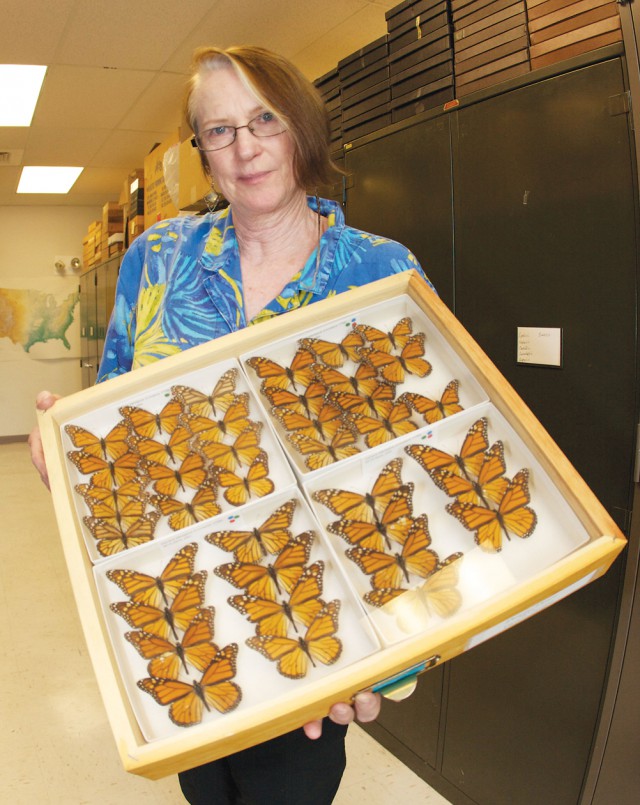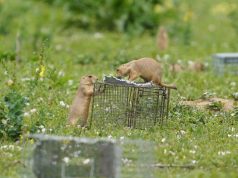
There are few species on this planet that inspire awe quite like the monarch butterfly. Its migration alone, which spans thousands of miles, is enough to get children interested in science and make adults appreciate the wonders of nature.
“It’s become such a representative of an incredible natural phenomenon, and people are interested in studying its biology,” says M. Deane Bowers, biology professor at the University of Colorado Boulder. “They’re beautiful to look at, and their biology is really interesting.”
One thing scientists have long studied, for instance, is the way in which the monarch, over four generations, makes its way north each year, and then how the fifth generation is able to return to the roosting place of its predecessors.
“The monarch is one of the few insects that makes such a huge migration,” says Kristy Schaad, lepidopterist at Denver’s Butterfly Pavilion. “No matter where they’re living the rest of the year — along the East Coast or through the Midwest — they’re all going to the same mountains in Mexico for winter, to a specific forest. They’re these tiny little insects and they make this huge journey. And it’s not always the same adult that’s going to be flying the whole way.”
Unfortunately, the monarch is facing a battle on two fronts, both on a loss of habitat here in the United States, where it reproduces, and in Mexico, where it “winters.” National Geographic reported in March that scientists who monitor the insects in Mexico had recorded an appreciably smaller group than in the past. The regal butterflies spotted this past winter occupied an area 59 percent smaller than last year, they said.
“Monarchs, and butterflies in general, are an indicator species. They’re a fairly sensitive animal,” Schaad says. “They elicit an emotional response from people, but they’re also an indicator of the health of an ecosystem. Because monarchs span so many different ecosystems, their decline indicates that ecosystems all around the world aren’t that healthy.”
The monarch’s reign lies mostly to the east of the Rocky Mountains, where the insects can be seen in huge numbers flying from their wintering grounds in Mexico all the way up to Canada. Bowers says monarchs were sighted in Colorado in June, but they should fully arrive in Boulder County sometime in July.
“The thing about monarchs, what’s captured people’s imagination, is that they’re like birds, but they’re ‘just’ an insect,” Bowers says. “People don’t think of insects as being able to migrate the way birds can. And yet they do.”
The migration may be awe-inspiring, but the lifecycle of the monarch is no less magical. A tiny egg laid on a milkweed plant hatches into a caterpillar, or larva. The caterpillar feeds on the milkweed leaves until it’s nice and plump, and then, sensing that it’s time for a makeover, spins a silky cocoon in which it “sleeps” for about 10 days. When it emerges, it’s not a caterpillar that appears, but a vibrantly colored butterfly. That butterfly then flies north to find a milkweed plant to lay its eggs on.
So, what happens when milkweed plants are hard to find?
“If they don’t find milkweed, and they don’t get to lay their eggs, obviously we’re looking at a much smaller monarch population,” Schaad says.
The No. 1 threat to the monarch, according to a University of Kansas organization called Monarch Watch, is habitat loss. In Mexico, logging has eliminated many of the trees monarchs historically use for hibernation. In the United States, milkweed plants are being threatened by development and the increased use of genetically modified organisms, the group’s website (www.monarchwatch.org) explains.
“In the United States, 6,000 acres are converted to development each day, eliminating milkweeds needed by monarch larvae and nectar sources required by adult monarchs,” the website reads. “Chemically intensive agriculture and roadside management by excessive mowing and use of herbicides have also eliminated monarchs and their milkweed hosts.”
Bowers and Schaad also point to research indicating that the use of GMOs has had a negative affect on monarch habitat.
“Farmers spray pesticides to get rid of the bugs, but butterflies are insects,” Schaad says. “Pesticides will affect them, and generally not in a positive way.”
The byproduct of more GMOs is the increased use of pesticides and herbicides, says Sarina Jepsen, program director at the Xerces Society, which monitors monarchs. The Oregon-based Xerces Society was named after the extinct Xerces blue butterfly, which called San Francisco home before its lush native habitat was destroyed.
“As monarchs are flying throughout the U.S., it’s important that they be able to find milkweed,” says Jepsen. “Historically, a lot of milkweed would crop up in corn and soy fields, and on crop edges. But now that growers have these new GMO crops that are ‘Roundup-ready,’ they’re able to spray their whole crop and quite easily wipe out anything that is not their crop. It’s led to a lot less milkweed across the landscape.”
Climate change — in particular, warmer temperatures and less moisture — has also affected the monarch’s habitat, explains Schaad, who notes that these same issues were affecting other butterflies native to Colorado as well, including the eastern black swallowtail.
The monarch is not on any endangered species list. In fact, Jepsen says, they probably still exist in the millions. But it’s clear that the monarch’s habitat is being threatened, and mostly by human actions.
Bowers and Schaad both suggest planting a butterfly garden as one way concerned citizens can help out this majestic butterfly. People can plant milkweeds in addition to nectar plants. With that butterfly garden in place, Schaad warns against spraying herbicides or pesticides.
Bowers also points to organizations like Monarch Watch, which offer opportunities for people to get involved in butterfly tagging and counting. In addition, Schaad’s Butterfly Pavilion is actively seeking volunteers for butterfly monitoring sites around Colorado, including several in Boulder County.
“I think losing such a unique biological phenomenon would be really distressing,” Bowers says. “Is that going to make a difference to humans in terms of how we live our day-to-day lives? Probably not. But as far as our appreciation for the natural world and what humans are doing to our natural world, monarchs are an icon for that.”
Respond: [email protected]














